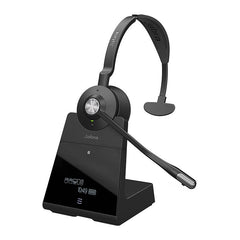If your business uses softphones, you’ll want to make sure that the VoIP headsets you buy are compatible. We carry a variety of headsets that are fully compatible with over 99% of softphones.
Best Headsets for Softphones
Leitner Premium Plus LH570
This is the top-of-the-line wireless USB headset, and it’s compatible with over 99% of softphones. Designed for maximum productivity and comfort, it features a functional, yet sleek design. The integrated FocusLight alerts others when you are on a call, up to 350 ft of range, and the ultra-noise-cancelling microphone will keep the background noises away so your caller only hears your voice. Prefer dual-ear? Check out the LH575.
Sennheiser OfficeRunner
Works great with PC and Mac. What sets this wireless VoIP headset apart is that it’s convertible. You get two comfortable wearing options - Over-the-Head and On-the-Ear.
Leitner Premium Dongle LH470
This USB VoIP headset is specially designed to work with computers and tablets. Use in the office or on the go, no charging base needed. It connects wirelessly via DECT dongle that plugs into the USB-A or USB-C port on your PC, laptop, or tablet giving you wireless communication for up to 350 feet! If your business only uses softphones on the computer, then this would be the perfect headset for you. (Dual-ear option available LH475)
Leitner LH250
If wireless isn’t your thing, this is a great wired USB headset. Effortlessly connect to your PC or Mac via USB-A or USB-C. Features built-in volume controls, ultra-noise-cancelling microphone, and the moldable headband guarantees all day comfort. Does your computer have a USB-C connection? Try this version of the LH250.
Jabra Engage 75
This wireless USB headset connects with pretty much any softphone with help from the Jabra Direct app. You can even pair it with multiple softphones at once!
What is VoIP?
- VoIP stands for Voice over Internet Protocol. You might also hear it referred to as “Voice over IP.”
- The term VoIP references a type of technology that can be used by devices and software programs.
- VoIP systems allow you to make calls using your internet connection rather than a phone signal.
You can purchase a VoIP phone or download VoIP-enabled apps, but Voice over Internet Protocol itself is a technology, not a device.
What is a softphone?
- A softphone is the software that you use to make a call using an internet connection. It has the functionality of a phone without a physical device.
- You’ll use your softphone via an app, provided through your VoIP provider, or by logging online through your browser, such as Google Chrome.
- Some common softphones are RingCentral, Avaya Communicator, Zoom, and Microsoft Teams, to name a few.
In short, a softphone is an app or browser login, and it’s different from VoIP, but it requires VoIP technology in order to operate.
What else do I need to know about headsets for softphones?
- You’ll need a VoIP headset that can connect to whatever device(s) you’ll use to access your softphone.
- Wireless VoIP headsets are great if you’re trying to avoid adapters. They also allow for mobility, which is one of the exciting things about using a softphone in the first place.
- Bluetooth-enabled wireless headsets will allow for the quickest transition between devices. It can connect to multiple devices at once so if you’ve got your softphone app on a cell phone, tablet, and computer, this one’s for you.
- Wired VoIP headsets are an option for softphones, but if you're switching between devices, they're not as convenient as wireless.
- The best softphone headset for you depends on the devices you use and the softphone plan you have.
If you’d like to chat or aren’t sure if your softphone will be compatible, call our Headset Advisors at 1-800-HEADSETS (432-3738) or email info@headsets.com for extra guidance.






